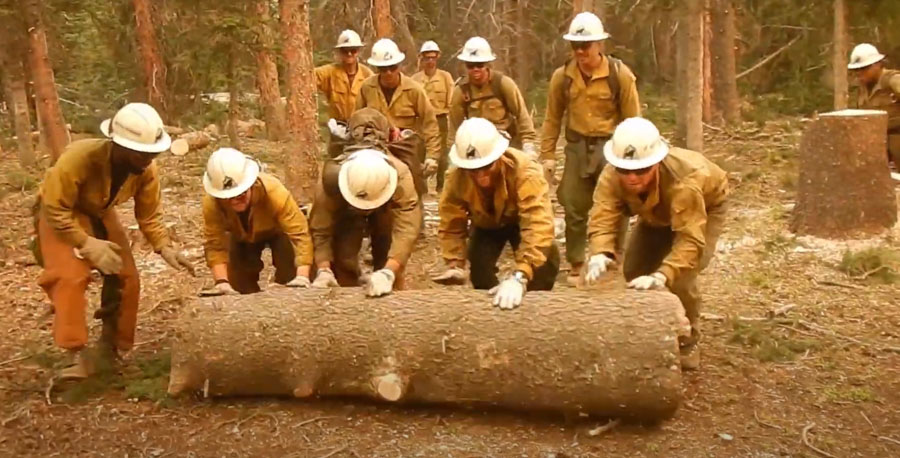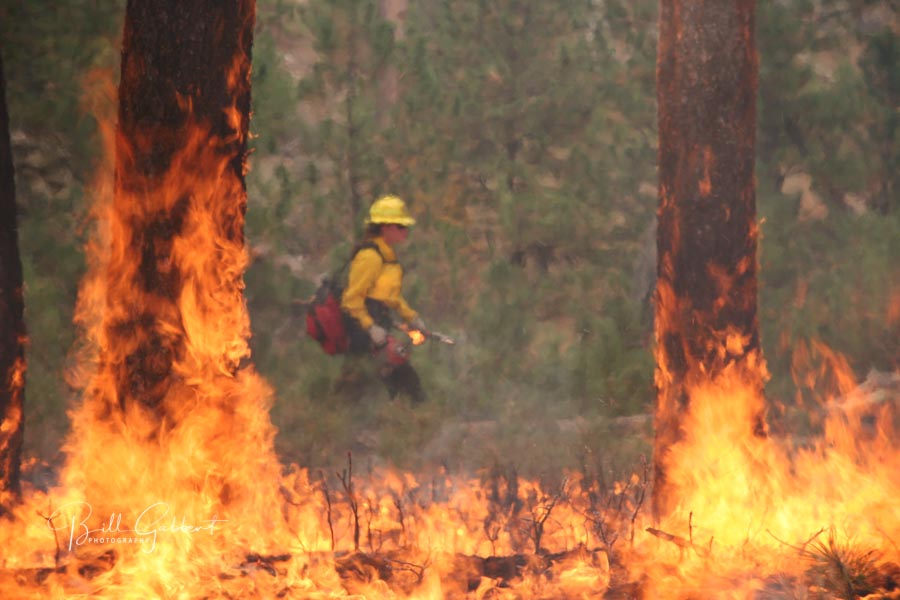
Many of the firefighters on the Route Fire who escaped from what was close to becoming a mass casualty incident on September 11, 2021 no doubt had stress levels that were very high as it was happening, and possibly for days, weeks, or months later.
As we covered in an article on December 11, dozens of firefighters on the fire north of Los Angeles suddenly found themselves on a road with fire on all sides of them. Even though it occurred three months ago the story had not been publicly told, until yesterday. As flames closed in on them, a Captain on a US Forest Service engine took charge and organized an effort for 13 firefighters on foot with no access to their regular transportation, to take refuge in two USFS Type 3 engines, each already carrying their normal complement of 5 firefighters. Almost unbelievably, 7 crammed into one engine and 6 got in another. There were a total of 23 bodies in the two engines. Then with flames on both sides of the road, they drove through smoke to safety. Two firefighters were treated in a hospital burn unit and released.
It could have been much worse. One person thought he was going to die.
“The more experienced firefighters were more shaken up than the new guys,” a firefighter told Wildfire Today. “Firefighters on the outside looking in were pretty shaken up, but as best as I can tell I think we are all doing good.”
One person said that as they were becoming entrapped and during the escape from the nearby flames he realized later that he does not have a complete memory of the event, “My memory blacked out from time to time…It’s psychology I don’t fully understand.”
Today I found a reference by Mike Degrosky to an article in the Harvard Business Review written by Diane Musho Hamilton that might shed some light on the topic. Interestingly, at the top of the article is an old photo of a P3 air tanker dropping retardant, even though the word “fire” is not mentioned anywhere in the piece. It starts with describing the two amygdala in the brain which were characterized by Dr. Bessel Van Der Kolk, in his book The Body Keeps the Score, as the brain’s “smoke detector.” (Which may be the genesis for the photo of the air tanker.) The amygdala’s job is to detect fear and help the body prepare for an emergency response.
Here is an excerpt:
“…When we perceive a threat, the amygdala sounds an alarm, releasing a cascade of chemicals in the body. Stress hormones like adrenaline and cortisol flood our system, immediately preparing us for fight or flight. When this deeply instinctive function takes over, we call it what Daniel Goleman coined in Emotional Intelligence as “amygdala hijack.” In common psychological parlance we say, “We’ve been triggered.” We notice immediate changes like an increased heart rate or sweaty palms. Our breathing becomes more shallow and rapid as we take in more oxygen, preparing to bolt if we have to.
“The flood of stress hormones create other sensations like a quivering in our solar plexus, limbs, or our voice. We may notice heat flush our face, our throat constrict, or the back of our neck tighten and jaw set. We are in the grip of a highly efficient, but prehistoric set of physiological responses. These sensations are not exactly pleasant — they’re not meant for relaxation. They’re designed to move us to action.
“The active amygdala also immediately shuts down the neural pathway to our prefrontal cortex so we can become disoriented in a heated conversation. Complex decision-making disappears, as does our access to multiple perspectives. As our attention narrows, we find ourselves trapped in the one perspective that makes us feel the most safe: “I’m right and you’re wrong,” even though we ordinarily see more perspectives.
“And if that wasn’t enough, our memory becomes untrustworthy. Have you ever been in a fight with your partner or friend, and you literally can’t remember a positive thing about them? It’s as though the brain drops the memory function altogether in an effort to survive the threat. When our memory is compromised like this, we can’t recall something from the past that might help us calm down. In fact, we can’t remember much of anything. Instead, we’re simply filled with the flashing red light of the amygdala indicating “Danger, react. Danger, protect. Danger, attack.”
“In the throes of amygdala hijack, we can’t choose how we want to react because the old protective mechanism in the nervous system does it for us — even before we glimpse that there could be a choice. It is ridiculous.”
The first large fire I was on, with El Cariso Hotshots, we had a near miss in Washington state, and had to escape uphill. It was a long, steep, hike out of a canyon with spot fires igniting around us. At the time I was not too concerned, in part because our Superintendent, Ron Campbell, seemed calm, as did the more experienced crew members. I was a sawyer and when another firefighter asked if I needed relief carrying the saw, I was too proud to give it up, and kept it. If I had known the true gravity of our situation I probably would have accepted his offer. As a rookie, I did not appreciate at the time how dangerous the incident was.
Five years later our Laguna Hotshot crew was directed to walk downhill on a partially completed fireline and extend it further. Two other crews were ahead of us. We only got a fairly short distance down the line when all of us were ordered out. We hiked back up to safety with no problem and later the fire ran uphill. After five years on a hotshot crew I didn’t really think too much about it, since to me it did not fall into the near miss category. It can be fairly routine to pull back when it becomes obvious nothing worthwhile can be accomplished or that it can become unsafe. However several days later after we had returned from the fire, one of the rookies quit, citing the event as the reason.
It can be impossible to predict how rookies or experienced firefighters will react to a terrifying narrow escape. It might be life-altering in a negative way, or something that is dealt with, and put away in the “slide file” of experiences to help make better, more informed decisions down the road.
I hope the firefighters on the Route Fire who were nearly entrapped, and those who witnessed it through smoke from a distance, are able to receive counseling if needed and can process what happened September 11, 2021. It’s the kind of traumatic event that can stick with a person and everyone is impacted differently.
As Sgt. Phil Esterhaus used to tell his Hill Street Blues cops as they left the briefing to begin their shift, “Hey. Let’s be careful out there.”





